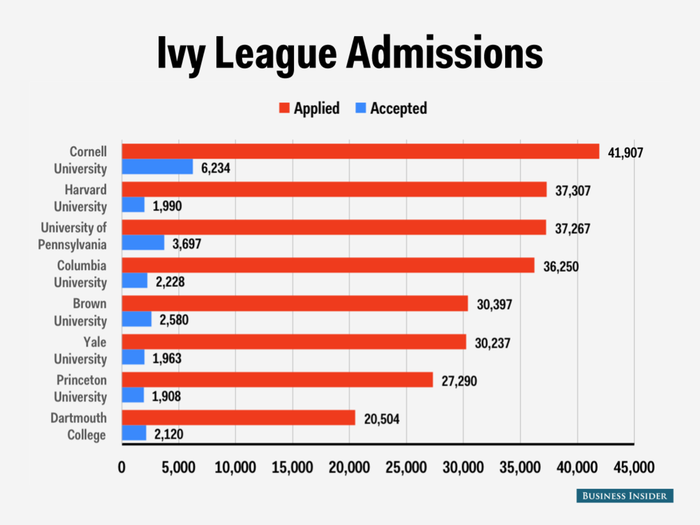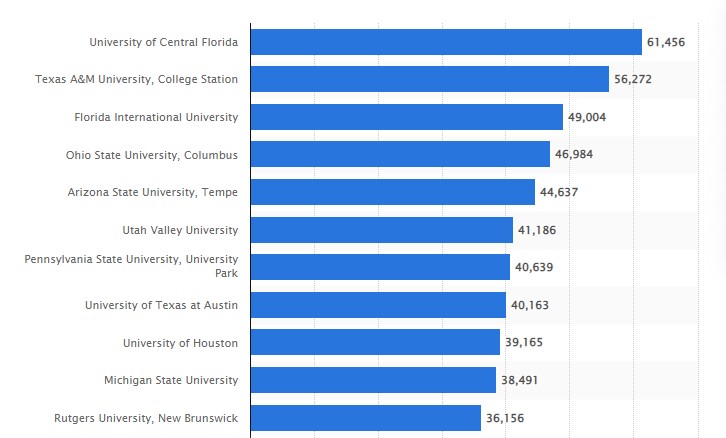Epistemic status: a very rough idea, that I have given relatively little thought to. I am not familiar with the details of how CEA and other organizations prioritize and allocate the support given to universities, so I might be missing very important details. I've only spent about 30 minutes putting together this post, so I might have some errors in here. View this as a rough draft of an idea.
The perception that I have, and what I think is a common perception in EA, is that funding and other support for student EA groups at the university level are mainly going toward "elite" universities: universities that are highly ranked by U.S. News & World Report, which have low admissions rates, and which have high test scores.
These undergraduate colleges[1] generally have only a few thousand students. Eight different EA student organizations at eight different ivy league institutions would be able to reach about 63,000 students[2], or about 8,000 students per organization.

Conversely, if we have eight student organizations at eight well-ranked (top 50) universities in the US with the highest undergraduate student populations, then those eight different EA student organizations would be able to reach about 287,000 students[3], or about 35,000 students per organization. The specific numbers will change depending on which universities are included, but the general idea is simply that maybe we should broaden the focus a bit and get more people, which means more skills. It seems like, despite the talent at ivy league institutions, we might actually end up getting more bang for our buck at less selective universities with higher student populations.

I don't want to imply that we should shift all resources away from Ivy League schools and toward more populous schools, but I do think it might be worth considering adjusting the strategy a little bit. If resources are distributed 80% to ivy league and 20% to other currently, then maybe we should shift it to 60% ivy league and 40% to other. At the least I'd propose finding a couple of populous universities and doing a trial run: create students groups and observe progress for a couple of years.[4]
My rough guess is that the average Harvard student is able to score better on standardized tests and is more well-connected to powerful people than the average Ohio State University student, but I'd also guess that there are more smart enough to make an impact in EA students[5] who are interested in making the world a better place within Ohio State University's 46,000 students than there are within Harvard's 5,000 students.
- ^
In reality most of these famous undergraduate colleges are a single college within a multi-college universities (such as Harvard College, which is only one of the 14 institutions that make up Harvard University), so if we include all the students at the various schools within the university that will affect the numbers. I'm just looking at undergraduate population here, because that is my understanding of where the focus is for EA student groups. However, I might be wrong about this.
- ^
These numbers come from https://www.collegeevaluator.com/ncaa-conferences/ivy-league/enrollment/, and I view then as roughly accurate rather than precisely accurate.
- ^
I got this number by looking at only at universities that are within the top 50 of the US News and World Report, and then summing up the undergraduate populations of the eight most populous: Ohio State University, University of Texas at Austin, University of Florida, Purdue University, University of Illinois at Urbana–Champaign, University of Wisconsin–Madison, University of California-San Diego, The University of California-Los Angeles.

As someone who organized at the University of Mississippi—a school of loosely 20K undergrads—I can say that I understand this sentiment and there probably is some merit to it, but I am also somewhat skeptical.
Tl;dr: Outreach capabilities presumably do not linearly scale with university size, and I suspect higher-prestige universities probably attract a substantially greater proportion (5x-20x?) of engagement-adjusted EA-inclined students than most middle-tier universities, which may offset the bigger pool at larger universities. But there are probably some mid- to high-tier universities with large populations worth targeting, and there may be other meaningful benefits (e.g., diversity)
TBC, I agree that there are probably a variety of >30K undergrad schools that might be good places to organize at, in part due to the larger population. Additionally, there are probably meaningful benefits from having a more socioeconomically and/or educationally diverse population (even if only so that EA doesn’t seem as elitist).
However, I found that despite Ole Miss’ population being larger by a sizable factor than many ivy schools, organizing at Ole Miss was far less effective relative to the experiences I’ve heard from many Ivy League schools.
With the caveats that I may have simply not been a good organizer (in part due to personality and in part due to the fact that I only had 3 semesters left and became busy with my thesis in the last two), the person who said they’d co-organize with me ended up flaking (and I wasn’t able to find another co-organizer), and COVID hit the semester after it was created: I probably put in some ~5-10 hours a week on average for most of the semester when I began the org, and still struggled to get people interested.
I put up fliers, blasted groupmes, told people in clubs (especially debate, which probably made up about 50% of regular attendance), tabled at the fresher fair, invited friends, ran informational sessions in welcome week, asked faculty to send emails to departments, got the org included in the honors college newsletter, gave brief presentations in a few classes totaling some 150–200 students (e.g., philosophy and ethics classes), got school funding for free pizza, and at one point even submitted an unrelated article to a student publication on the condition that the editor would attend a discussion meeting (his idea, not mine)—but still failed to attract a co-organizer or maintain sufficient attendance into the second semester.
(At the time, I was not aware of retreats and fellowships, and probably wouldn’t have had the capacity; they also might have been fairly new/limited in 2019)
In contrast, the stories I’ve heard and seen at more prestigious universities tend to be that even with a significantly smaller student population, a number of students happily dive into EA events with relatively little hand-holding or encouragement, and some even happily volunteer to help out with organizing.
In summary, some of my thoughts have been:
I think that you make a good point. The narrative of "bigger = better" is a vast simplification. Perhaps there are other useful factors in addition to student population that we can look at, such as "% of students majoring in non-profit management, environmental studies, etc." as a rough proxy for the level of "proto-EA-ness" in a student population.
I wonder if there is some good enough to be useful way to evaluate the prevalence of Proto-EAs on a university campus. I'm trying to think of how to create a rough/toy function the of: student population, prevalence of Proto-EAs (as measured by some proxy)... but what other factors would be useful?
If "eliteness" really is a useful metric, then maybe it would make sense to prioritize university outreach to the top X universities, but maybe X should be 30 or 50 or 80 rather than 10.
I expect this to be a pretty poor proxy fwiw.
I agree that those specific examples are probably not great proxies, but things related to machine learning or other important technologies might be good—especially in conjunction with information about the competitiveness of the programs.
Yeah there's way too many variables.
Anecdotally, the most engaged young EAs I've come across are usually heavily into liberal arts (a lot of philo and history majors) or CS majors. I'd find it difficult to make meaningful major-specific strategies off of that.
I agree that it is pretty sloppy/rough. Can you share any suggestions for better proxies?
Hmm at the (strong) danger of selecting too much on traits that I think I or my friends are likely to have, rather than predictors of actual expected impact:
I thought Joseph was trying to identify proxies that you could easily measure at the university level, e.g., by collecting stats from university webpages. Some of the proxies you mention—e.g., "enjoyment of rationalist-y writing"—don't seem to fit this goal, as they seem more targeted to the individual (or are just not already collected and reported at the university level). Granted, some such as IMO medalists and EA alumni representation do seem amenable to such analysis, although the latter seems like it would be a very laggy-metric.
Something like "existence of and participation in speech & debate clubs and related extracurriculars (e.g., ethics bowl, Model UN, Mock Trial)" seems like it would be worth looking into as a candidate.
I feel like I read that someone was working on this at some point, although maybe I just conflated this question with something related. Whatever I read that I am thinking of was probably co-authored by Lucius Caviola, but I'm not sure.
This actually aligns with my experience as well. Without external prompting, I find that students from "elite" schools were the most proactive. In Singapore there's only been one high school chapter. EA SG would have supported any HS student who asked, but that school was the only one that had any. Likewise, I later cofounded a climate advocacy org with someone I messaged on Twitter who was the first person to conduct climate protest in Singapore, and us cofounders were from the two top schools even though we would have taken anyone. I suppose it's combination of curiosity+privilege.
But in any case, I think it's good not to assume current movement trends reflect some universal truth. I think EA should broaden its reach as much as it can, and methodical attempts at boosting participation is good. Heck, if you look at the most common alma maters of EAs, there's some distinctly non-Ivy, non Russell Group unis at the top distributions that prove anomalous outrach efforts can make a difference. No reason to say no to that.
As someone who's been to a <5% acceptance rate school and a school that no one outside my city knows exists, I agree with this assessment.
To ground this discussion, I'll be using stats from the 2020 EA demographics survey.
Specifically, this chart of EA's alma maters.
As you can see, that's a huge overrepresentation from elite universities. Over 1/3 of respondents come from Oxbridge or T20 universities. The top-heaviness is even wilder if you dig into EA's funding sources. By 80k's own estimates, 80% of EA's funding essentially comes from the work of Dustin Moskovitz from Harvard and Sam Bankman-Fried from MIT.[1]
There's arguably some justification for this:
However, I think the argument for diversity remains compelling:
Overall, I agree. And for certain EAs reading this who remain unconvinced, I doubt EA would have grown to what it is today if Will Macaskill had decided that American EAs weren't worth the trouble of reaching out to, or that certain initially-unpopular cause areas weren't worth acknowledging.
Yes, I know FTX has a very EA-aligned team and is not just SBF. However, if you attempt to break down the actual alma maters of the FTX leadership, you'll find it only strengthens my point.
I also agree that an EA priority in the next decade is to become more diverse, and applaud this for being a tractable first step, not a full solution.
This feels very related to the recent post Most Ivy-smart students aren't at Ivy-tier schools, which notes near the beginning: